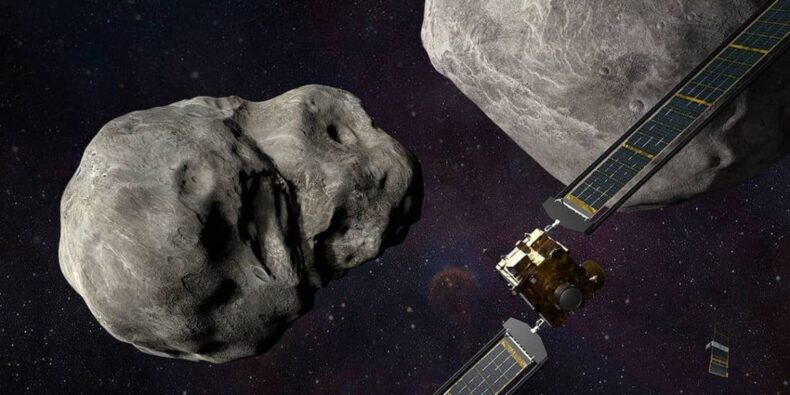All about the Double Asteroid Redirection Test (DART)

What is DART?
DART is the first-ever mission dedicated to investigating and demonstrating one method of asteroid deflection by changing an asteroid’s motion in space through kinetic impact.
The DART spacecraft was launched on 23rd November 2021 aboard a SpaceX Falcon 9 Rocket from Vanderberg Space Force Base in California. It took 10 months to reach its target.
All of this might seem very overwhelming. So let us first understand what caused a dent in the straight course of life to come up with something like DART.
The NASA Team were compelled to come up with DART because of the K-T mass extinction.
What is K-T Mass Extinction?
The Cretaceous–Paleogene (K–Pg) extinction event [also known as the Cretaceous–Tertiary (K–T) extinction] was a sudden mass extinction of three-quarters of the plant and animal species on Earth, approximately 66 million years ago.
It marks the end of Mesozoic era to which dinosaurs are believed to belong to. So, basically, the K-T extinction was also the reason for the extinct of dinosaurs from Earth.
The post K-T extinction event records a formation of something called the K-Pg boundary which can be found in marine and terrestrial rocks. The particles of the rock on examining showed an unusual amount of metal Iridium.
After this, scientists speculated that the K-T Extinction was a result of a big asteroid collision that had happened 60 million years back on Earth. This was because Iridium is present in large amount in asteroids.
The speculations were confirmed to be true with the discovery of the Chicxulub Crater in the early 1990s in the Gulf of Mexico‘s Yucatán Peninsula.
According to reports, a large number of asteroids strike the Earth. They end up not being that destructive as most of the rock melts while they travel through layers of Earth’s atmosphere. But that shouldn’t be a very promising reason for us to be believe that catastrophic asteroid collision shall never happen. The real-world threat always tags along.
This is the reason why NASA came up with the DART mission.
NASA is working on this mission with the underlying theory of Kinetic Impactor Deflection.
What is Kinetic Impactor Deflection?

Kinetic Impactor Deflection involves impacting an asteroid with a spacecraft traveling at high speed delivers an impulsive change in velocity to the body. In certain circumstances, this strategy could be used to deflect a hazardous asteroid, moving its orbital path off of an Earth-impacting course. This could deflect the asteroid into a different trajectory, steering it away from the Earth’s orbital path.
Kinetic Impactor is used to dodge off or prevent our planet from an approaching near-earth object.
But as science outgrows human possibilities, scientists from NASA have gone ahead with an objective of creating more useful data related to asteroid.
NASA has used Kinetic Impactor deflection by sending a spacecraft into far space. This spacecraft is said to strike a target asteroid. On the collision, the target asteroid will change its trajectory along with its velocity.
The target asteroid is Dimorphos. Dimorphos is a small asteroid satellite that was discovered in 2003. It is a moonlet to a parent satellite Didymos.
It is to be clear that Dimorphos is not a threat to Earth at least for now. Scientist have chosen Dimorphous as it orbits around a bigger asteroid, Didymos. This makes it ideal for any Earth related study as it might resemble any smaller space object in relation to Earth.
Scientist are trying to create an artificial asteroid collision which doesn’t involve Earth but the data from it can come in handy to knock off an approaching asteroid that can prove catastrophic to the life on Earth.
When the DART space craft will hit Dimorphos, it will change the asteroid’s speed and trajectory along some other factors. The DART space craft is functioned with high quality camera which will record all the changes in the surrounding until it gets destroyed as it hit Dimorphos.
Once the collision is completed, NASA will study the event through telescopes as Dimorphos isn’t that far from Earth. NASA will study the change of course of action of the smaller asteroid with respect to the bigger Didymos.
If everything goes as planned, NASA will have enough future planetary defense weapons based on valuable information retrieved from the DART mission













